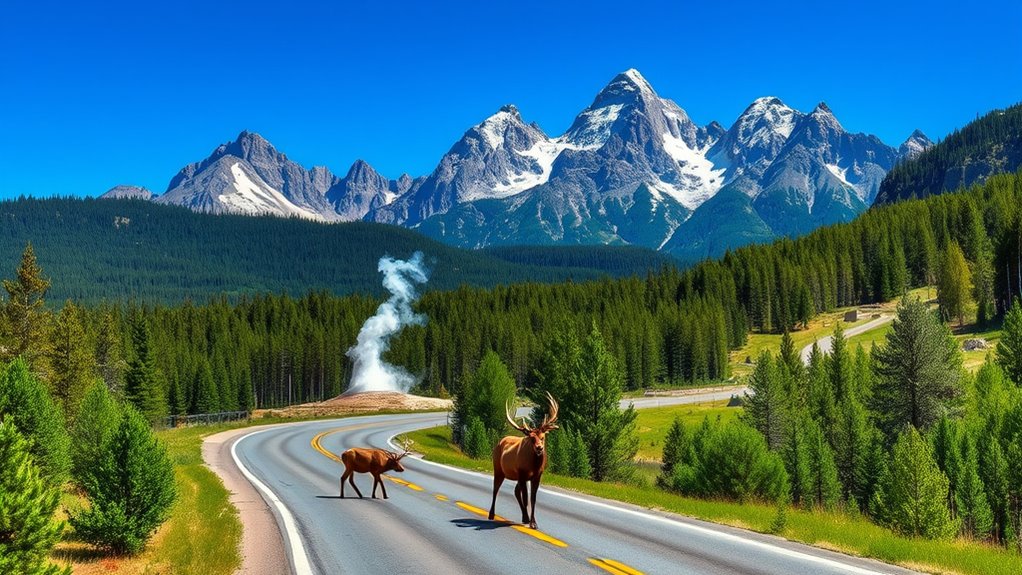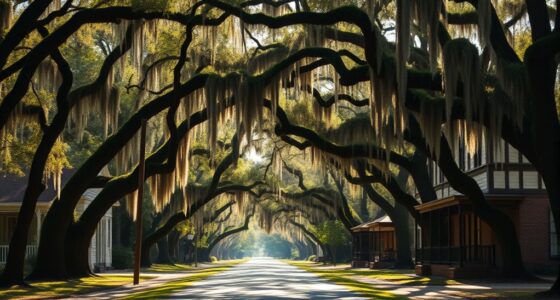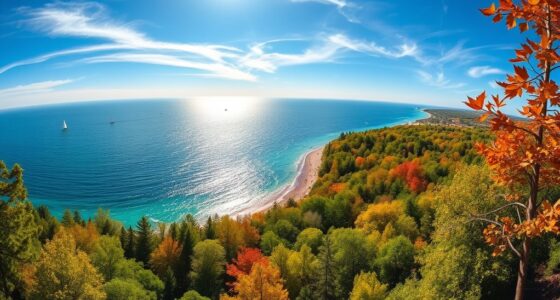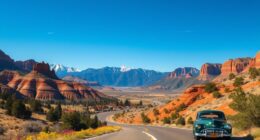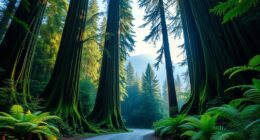On a Yellowstone and Grand Teton road trip, you’ll experience incredible geothermal features like erupting geysers and vibrant hot springs alongside thriving wildlife such as bison, elk, bears, and wolves. Capture these stunning scenes during early mornings and late evenings for the best wildlife encounters. Stop at scenic viewpoints to photograph steaming vents and colorful springs against mountain backdrops. Keep exploring to discover tips for making the most of your adventure while respecting park regulations.
Key Takeaways
- Plan visits during early mornings or late evenings for optimal wildlife sightings and geothermal activity photos.
- Explore geothermal features like Old Faithful and Grand Prismatic Spring for vibrant landscapes.
- Use viewpoints and boardwalks for capturing steaming vents, hot springs, and erupting geysers.
- Observe park regulations to ensure responsible photography and preservation of natural wonders.
- Incorporate diverse landscapes, including mountains and forests, to create dynamic, memorable shots.
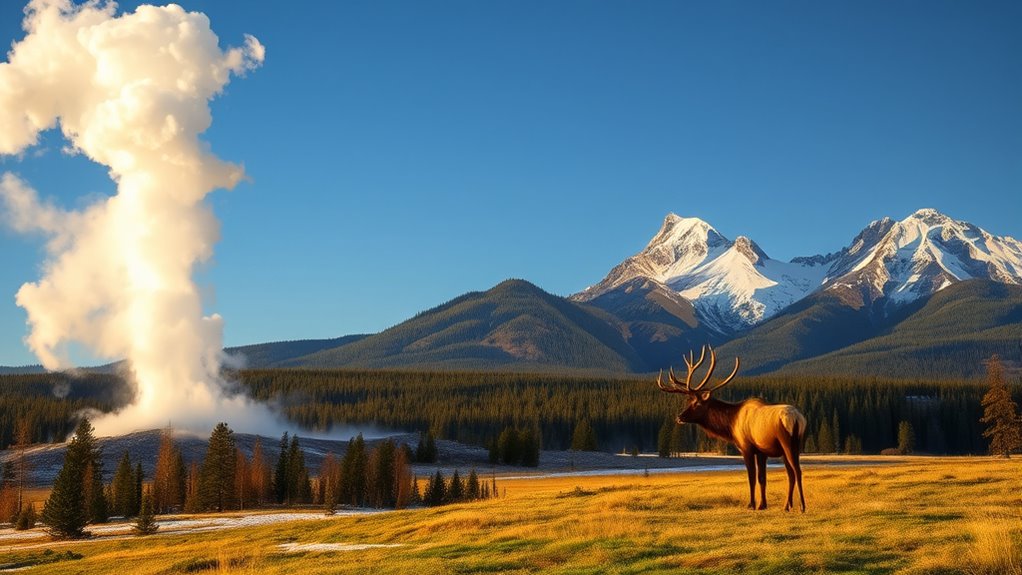
Beginning a road trip through Yellowstone and Grand Teton National Parks offers an unforgettable adventure filled with stunning landscapes and wildlife. As you traverse these iconic parks, you’ll discover a wealth of opportunities for wildlife photography and marvel at geothermal features that define Yellowstone’s landscape. Keep your camera ready, because spotting bison grazing in open meadows or elk wandering through forested areas is common, and capturing these moments will become some of your most treasured memories. The parks are teeming with wildlife, and your attentive eye will reward you with close encounters with creatures like bears, wolves, and deer, especially during early mornings and late evenings when animals are most active.
Yellowstone’s geothermal features are equally mesmerizing. The park is famous for its geysers, hot springs, mud pots, and fumaroles, which create a surreal landscape that seems almost otherworldly. The iconic Old Faithful geyser erupts predictably, offering a spectacular display of water and steam that you shouldn’t miss. Nearby, the colorful Grand Prismatic Spring showcases vibrant hues that literally glow with mineral-rich waters. As you explore the geothermal areas, you’ll notice the unique patterns and textures formed by mineral deposits, providing fantastic opportunities for detailed and striking wildlife photography and landscape shots. The contrast between the fiery springs and the surrounding lush greenery creates a dynamic scene that’s perfect for capturing with your camera.
While driving through these parks, take time to stop at various viewpoints and boardwalks that lead to geothermal features. Each stop presents a chance to photograph the movement of steaming vents or the shimmering surfaces of hot springs, all set against the backdrop of rugged mountains and dense forests. Your camera will thank you for the chance to freeze these fleeting natural phenomena. Remember, patience is key—wildlife and geothermal activity can be unpredictable, so allow yourself time to wait for the perfect shot or moment.
Additionally, understanding the permitting and inspection requirements can enhance your experience by ensuring you stay compliant with park regulations and preserve these natural wonders for future visitors. In essence, your road trip through Yellowstone and Grand Teton will be a blend of exhilarating wildlife encounters and mesmerizing geothermal landscapes. Whether you’re capturing a herd of bison against a steaming geyser or framing the vibrant colors of a hot spring, every shot will remind you of nature’s raw beauty. Take your time, stay alert, and enjoy every moment of this incredible journey that showcases some of the most iconic and picturesque features of America’s national parks.
Frequently Asked Questions
What Is the Best Time of Year to Visit Yellowstone and Grand Teton?
You should visit Yellowstone and Grand Teton during shoulder months like late spring or early fall to avoid peak season crowds. These times offer excellent wildlife viewing, fewer visitors, and pleasant weather. Summer is popular but crowded, while winter provides stunning snow landscapes if you’re prepared for cold. Planning your trip during shoulder months balances good weather, wildlife sightings, and a more relaxed experience.
Are There Guided Tours Available Within Both Parks?
Did you know that over 150 ranger-led programs take place annually in Yellowstone and Grand Teton? Yes, guided tours are available to enhance your experience, offering insights into the parks’ history and wildlife. Ranger programs cover topics like geysers, bears, and geology, providing an educational adventure. You can join these tours or programs to deepen your understanding and appreciation of the parks’ unique ecosystems.
How Accessible Are the Parks for Travelers With Limited Mobility?
You’ll find Yellowstone and Grand Teton quite accessible for travelers with limited mobility. Both parks offer accessible pathways that make it easier to explore key sights, and mobility rentals like wheelchairs are available at visitor centers. Be sure to plan ahead, check specific trail and facility accessibility, and contact park services for any special accommodations. With these options, you can enjoy the stunning scenery and unique features comfortably.
What Are the Safety Tips for Wildlife Encounters?
Think of wildlife as a fire—you must respect its power. Always keep a safe distance, observing wildlife behavior to avoid startling animals. Carry safety gear like binoculars and bear spray, and never feed or approach animals, as they can become aggressive. During my visit, I saw a bear calmly walk away when I backed off, reminding me that respecting wildlife’s space keeps everyone safe. Your caution is your best defense.
Can I Access the Parks With a Standard Vehicle or Is Special Gear Needed?
You can access the parks with a standard vehicle, as most roads are paved and suitable for regular cars. However, check current conditions before your trip, especially if you’re planning to explore off the main routes. In winter or during snow, snow tires or chains may be required for safe vehicle access. Always carry the necessary gear, like a full tank of gas, maps, and emergency supplies, to guarantee a smooth visit.
Conclusion
Your Yellowstone and Grand Teton adventure is like stepping into a living postcard, filled with geysers that dance and wildlife that roams freely. As you leave, remember that these treasures are a gift waiting to be explored again. The memories you’ve gathered are like sparks from a fire, warming your heart long after the trip ends. Keep these moments close, and let your wanderlust continue to guide your next great adventure.
